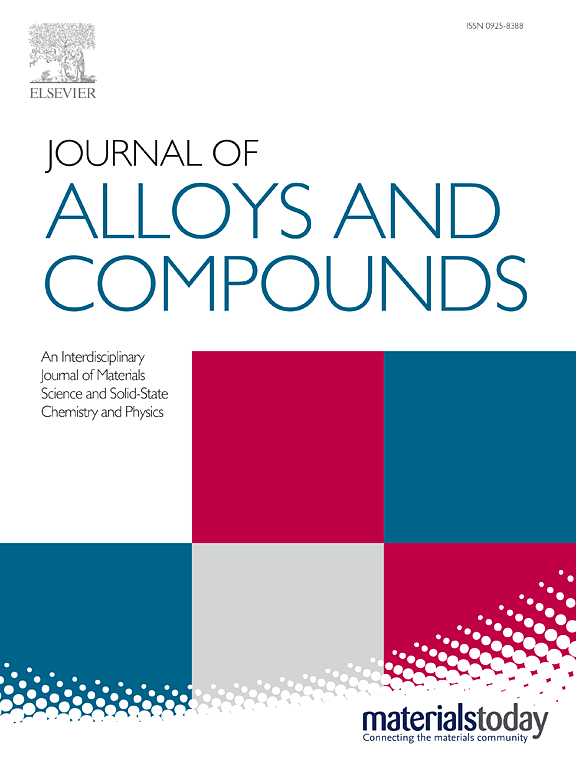Reactive Ball Milling-Induced Improvement in Hydrogen Storage Performance of Mg-Co Alloys
IF 6.3
2区 材料科学
Q2 CHEMISTRY, PHYSICAL
引用次数: 0
Abstract
The ability of magnesium-based hydrogen storage materials to store and release hydrogen is hampered by their relatively slow rates. To address this, Mg-x% Co (x = 5, 10, 15) magnesium-rich hydrogen storage alloys were fabricated using reactive ball milling. The resulting alloys were multiphase, composed of Mg, Co, MgCo₂, and Mg₂CoH₅, which provided nucleation sites and improved hydrogen uptake. The reduced particle size and surface microcracks and pores enhanced hydrogen diffusion. The Mg-15%Co alloy had the ability to take in 4.72 wt.% hydrogen in 1 minute when the temperature was set at 350°C. Hydrogenation resulted in the formation of a biphasic structure composed of Mg₂CoH₅ and Mg₆Co₂H₁₁. This structure destabilized the Mg-H bond and improved the kinetics of hydrogen release. The hydrogen release capacity first increased and then decreased with Co content, with Mg-10%Co showing the best performance. Due to the combined action of ball milling and Co catalysis, the Mg-10%Co alloy had an activation energy for hydrogen release of 113.65 kJ/mol, making it the alloy with the lowest such activation energy in the set. Differential scanning calorimetry (DSC) analysis confirms that cobalt addition reduces the hydrogen release peak temperature of Mg by 16.58–29.67 °C, with the Mg-10% Co alloy exhibiting peak temperatures of 410.72–425.53 °C, attributed to synergistic decomposition of MgH₂ with intermediate hydrides like Mg₂CoH₅ and Mg₆Co₂H₁₁. The findings of this study indicate that alloying Mg-based alloys with transition elements while performing ball milling is a practical method for enhancing their hydrogen storage and release kinetics.反应球磨对Mg-Co合金储氢性能的改善
镁基储氢材料储存和释放氢的能力受到其相对较慢的速率的阻碍。为了解决这个问题,采用反应球磨法制备了Mg-x% Co (x = 5,10,15)富镁储氢合金。所得合金是多相的,由Mg, Co, MgCo₂和Mg₂CoH₅组成,提供了成核位点并改善了氢气吸收率。颗粒尺寸减小,表面微裂纹和微孔增强了氢的扩散。当温度设定为350℃时,Mg-15%Co合金能够在1分钟内吸收4.72 wt.%的氢。氢化导致形成由Mg₂CoH₅和Mg₆Co₂H₁₁组成的双相结构。这种结构破坏了Mg-H键的稳定性,改善了氢的释放动力学。随着Co含量的增加,氢气释放量先增大后减小,以Mg-10%Co表现最好。由于球磨和Co催化的共同作用,Mg-10%Co合金的氢释放活化能为113.65 kJ/mol,是该组合金中氢释放活化能最低的合金。差示扫描量热法(DSC)分析证实,钴的加入使Mg的氢释放峰温度降低了16.58-29.67℃,Mg-10% Co合金的峰值温度为410.72-425.53℃,这是由于MgH₂与Mg₂CoH₅和Mg₆Co₂H₁₁等中间氢化物的协同分解。研究结果表明,在球磨过程中加入过渡元素是提高镁基合金储氢和释放动力学的一种实用方法。
本文章由计算机程序翻译,如有差异,请以英文原文为准。
求助全文
约1分钟内获得全文
求助全文
来源期刊

Journal of Alloys and Compounds
工程技术-材料科学:综合
CiteScore
11.10
自引率
14.50%
发文量
5146
审稿时长
67 days
期刊介绍:
The Journal of Alloys and Compounds is intended to serve as an international medium for the publication of work on solid materials comprising compounds as well as alloys. Its great strength lies in the diversity of discipline which it encompasses, drawing together results from materials science, solid-state chemistry and physics.
 求助内容:
求助内容: 应助结果提醒方式:
应助结果提醒方式:


